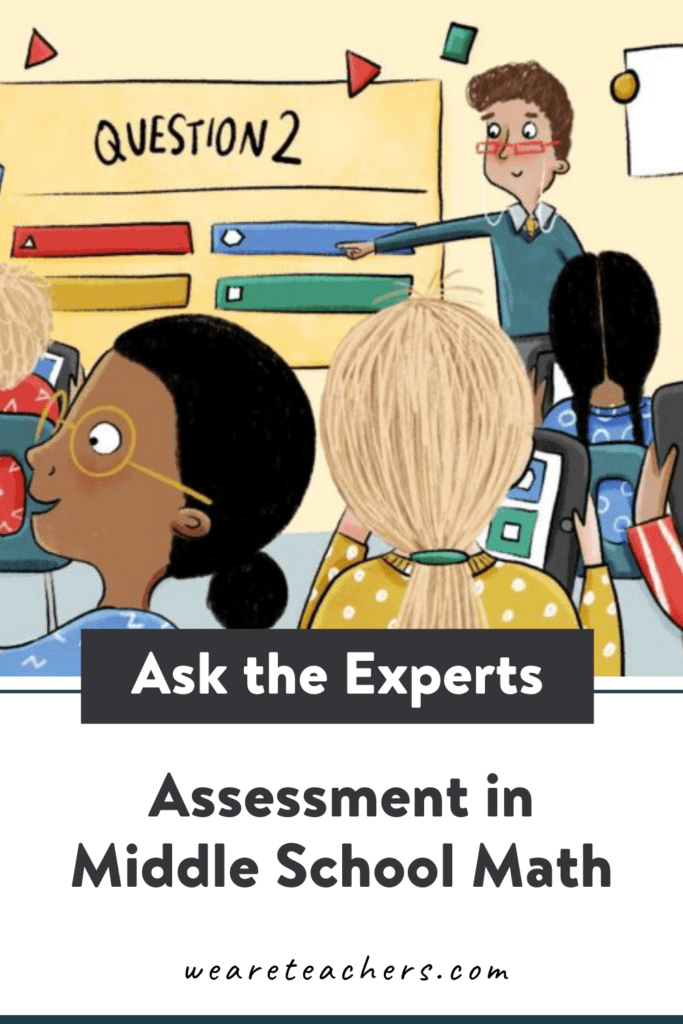Making intentional choices about assessments in your class can be tricky. While you understand how it’s useful for monitoring progress, it also helps you reflect on your teaching and how effective it is. Still, there are lots of questions about assessment and its proper role. Sometimes it seems that its importance may even be overly emphasized. Four experienced middle school math experts weigh in here on some common questions about assessment, sharing their perspectives and best ideas.
- Should I be grading every assessment I do?
- How do I assess understanding vs. memorization?
- How can I make my observation time create less student anxiety?
- Is there a good way to reduce test-taking anxiety? .
- Do all students need to explain their thinking?
- Can I move on, even if some of my students aren’t understanding everything?
- Coach’s Corner: How do I help teachers use their data to inform their teaching?
“I use a variety of assessments to help me understand how well students are doing. I don’t grade all of these, as some are pretty informal. Should I be giving each assessment a grade?”
Margaret Bowman, a math academic designer with McGraw Hill, responds, “This is a great question. Truly, the answer all comes down to the purpose of each assignment. You mentioned that you’re looking to see how well students are doing. What are you doing with those insights once you have them? If you’re tracking them in a way that allows you to differentiate and individualize instruction based on student performance, and keeping a log of student growth, then you’re already going above and beyond. Translating those insights into scores is entirely up to you and your school policies. You might also consider sharing progress data with students. Students learn best with consistent and immediate feedback, so any informal feedback you can provide will only help them improve.”
Linda Scanlan, middle school math coach, Princeton Junction, NJ, agrees, “Not all assessments, particularly formative ones, need to be graded. However, feedback should always be given for every assessment. Feedback should be specific and address goals. The teacher can also involve students in self-assessment by providing criteria for success when meeting a goal.”
“Some of my students are very good at memorizing procedures, but I’m not sure they really understand what they are doing. I find this particularly true with geometry proofs and algebraic equations. How do I assess their true understanding of these ideas?”
Mike Delasandro suggests, “For algebra, you might come up with problems that not only require solving equations but require the students to write the equations. You can also give the students an equation and tell them to write a real-world problem that could be solved using that equation. In addition, you can ask students to explain their work, or ask them to explain ‘why’ they were able to use specific equations to solve problems.”
Margaret Bowman says, “Many students make it through math courses without a fundamental understanding of core concepts. The rise in attention paid to sense-making in mathematics points to how many educators recognize this issue. Sense-making is encouraging students to explain their thinking and identify the strategies they used to come up with an answer—or, as math educator and thought leader, Annie Fetter, refers to it, the opposite of answer-getting. To encourage your students to engage in sense-making, consider some classic sense-making activities: Give them the answer to a problem and ask them to write out the steps to get there; get rid of the question altogether and instead begin by encouraging observations, or ask about ideas, but not answers—for more on sense-making, I would encourage any teacher to read Annie Fetter’s work.“
“I do a lot of observation and note-taking as part of my overall assessment plan. I walk around the room and take notes on what I observe individual students doing so I won’t forget. Some students say it makes them nervous. Should I still do this? How do I explain it and calm them?”
Linda Scanlan urges making students part of the process. She says, “Be transparent. As you walk around the room taking notes, talk to students as well. Tell them what you wrote, explain why it is written down and what it is used for. Ask students to reflect on their learning, their collaboration, problem-solving skills, etc. Develop two rubrics together to record observations—one each for the teacher and the student. When student voices are heard and included, they are less likely to be nervous.”
David Hatfield, a lead learning scientist with McGraw Hill, also considers sharing the purpose of note taking to be important and sees an excellent opportunity in this scenario. “First of all, kudos to you for having such a dynamic and holistic approach to understanding student learning. The anxiety from students is an opportunity to support a culture of growth in your classroom and foster student agency. Remind students that you’re a learner too and student experiences in the classroom teach you. Your willingness to model how you improve your own practice will help set the tone and build the trust to dissipate concerns.”
“I have a number of students who have real test-taking anxiety. They do great on the classwork and homework, but when it comes time for the test, they don’t do as well as I know they are capable of doing. How can I help them with this?”
To get on top of this Linda Scanlan suggests trying to get at the root of things by enlisting all the stakeholders. “When students have test-taking anxiety, the teacher, guardians, and guidance counselor need to work together to find out why. Does the anxiety only happen in math class, or does it happen in all classes? Is it the atmosphere or the timing of the test? Does the student not have confidence or a growth mindset? Only when the root of the problem is identified can the teacher, guardians, and guidance counselor work to develop a plan to make the students comfortable in test-taking situations.”
Mike Delasandro says it’s a good idea to address it as you see it happen. “You may want to check in with them during the test. If you notice that they are off on some particular problems, you could remind them of the time that they were able to complete these problems in class or on a homework assignment. You could say something like, ‘Remember when we added fractions in class, and you gave the correct answer? What did you do with the denominators?'”
“I have students explain their thinking on some of the math assessment questions I give. One student told me he ‘just knows the answer’ and that it takes too long to write his thinking down. He does very well, so I know he understands the material, but I think it’s important that he be able to explain it as well. Should I still require him to do this?”
Mike Delasandro immediately saw the value in this teacher’s assessment approach and made some solid, practical suggestions to try. He says, “I think it’s important for students to prove they understand the concepts. If the writing is difficult for this student, perhaps he can prove his understanding another way. See if you can ask him to show a formula, draw a picture, or use a diagram. If he’s resistant to showing the work, have him show his work on one or two problems only. This will help you see that he understands the concept.”
David Hatfield applauded this teacher’s thinking, “Having your students explain their thinking is a valuable skill needed beyond the ability to produce answers. First, it rehearses the student’s understanding which will likely make such memories more durable over time. Second, it helps reveal gaps in understanding. We all routinely convince ourselves that we know or understand more than we actually do. Needing to articulate what we think we understand can be a great way to locate gaps. Finally, it’s also a great habit to encourage. When your student encounters challenges that aren’t easily solved, being able to step through a self-explanation will help highlight potential mistakes. The fact that your student feels that providing these explanations takes too long suggests this could be a great opportunity for him to expand his math skill set and learn how to do this better.”
“I just gave my class an end-of-unit assessment on geometry. Most of them did really well, but I have four students who did not do well at all. They’ve done fine on all of our other units, but they just did not get geometry. Do I just move them on to the next unit? Any suggestions?”
Linda Scanlan saw the need for differentiation here while still emphasizing the importance of the material. She says, “At some point, students will need the geometry concepts to build to further topics. So while the teacher may need to move on to the next unit, the four students will still need some instruction and remediation on this unit. As the new material is presented, other units can be spiraled in or connections can be made between units. Small group instruction can take place as an intervention with the four students for the specific concepts they struggled with as identified on the assessment.”
Margaret Bowman was excited by what might be possible and is also an advocate of spiraling it forward. She remarked, “This is such a great question! Mistakes in math—even on tests—are part of the learning process. Help students develop the mindset that there is value in their mistakes. Encourage them to embrace their mistakes and, most importantly, learn from them! Just because the unit assessment has been given does not mean that the opportunity for learning the content is over. When students learn from their mistakes, it can provide insight into their misconceptions and help them to develop deeper understanding of the concepts. Start by having students make corrections on the test by providing the correct answer and a brief explanation of what error was made the first time and how it was corrected. Try to support those students without disrupting your whole-class instructional progress. You might consider building differentiated homework assignments into your lesson plans. Any time you have dedicated to independent learning in class is also a good opportunity to address their knowledge gaps with targeted assignments.”
“How do I encourage the teachers I coach to informally and formally assess students on a more regular basis to help drive their daily instructional choices rather than just collect scores?”
Math Coach Linda Scanlan says, “You can model this in class with the teacher. Plan a lesson together to informally and formally assess students. This can be done with notes, feedback, and strategic questioning. You can also do this during small group instruction. Once this data is collected, plan the next lesson together based on the results. Make yourself available to plan and implement both lessons.”
Margaret Bowman, McGraw Hill, shared an important reminder that every teacher is different and every student, as well. She remarked, “Consider a teacher’s particular strengths, needs, and motivators. You may want to move away from thinking of this as a conversation about ‘assessment’ and instead about bringing every student’s needs into focus. Reinforce that every observation of student progress doesn’t have to be reflected as a grade or even be shared with a student, depending on the context. The goal of informal and formal assessment to drive instruction, as you put it, is to learn more about each learner. It’s a matter of collecting information about their experience in the classroom to better understand what they know, what they don’t know, and what they need to learn next. Some teachers might associate ‘assessment’ with a certain weight—and subsequent judgment. Framing this work as a matter of inquiry and discovery, a matter of getting to know every student and giving them exactly what they need to thrive, is a truer reflection of your goals as a coach.”
Want more math expert advice? Check out Ask the Experts: Differentiation in Middle School Math
Illustration: Jennifer Jamieson



